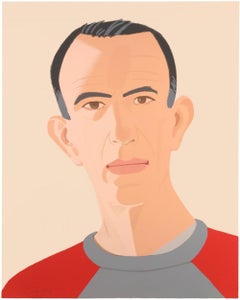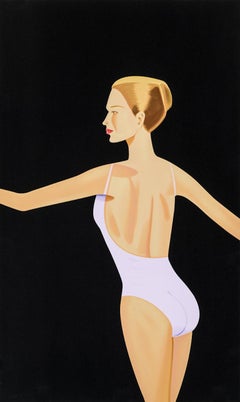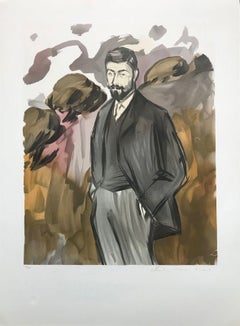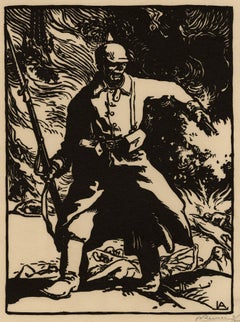Face Portrait Prints
to
575
1,316
547
651
357
209
Overall Width
to
Overall Height
to
897
638
255
134
114
73
56
46
44
41
19
4
3
2
148
64
51
46
39
171
510
1,707
712
20
47
98
84
82
79
205
321
222
79
142
2,454
452
166
6,526
3,594
3,100
2,613
1,932
1,554
1,221
1,137
945
793
757
417
379
363
246
215
200
189
176
169
1,125
801
452
284
179
487
1,353
1,592
1,019
Art Subject: Face
Sweatshirt 2 (Alex and Ada Suite)
By Alex Katz
Located in Miami, FL
TECHNICAL INFORMATION
Alex Katz
Sweatshirt 2 (Alex and Ada Suite)
1990
Screenprint
36 x 28 5/8 in.
Edition of 150
Pencil signed and numbered
Accompanied with COA by Gregg Shienbaum...
Category
1990s Contemporary Portrait Prints
Materials
Screen
Portrait of a Self Portrait of a Self, as Marilyn (Set of 3) 2023
Located in Zug, CH
Douglas Gordon
Portrait of a Self Portrait of a Self, as Marilyn (Set of 3)
2023
Print on canvas, inner frame, Dibond backplate
120 × 120 cm
(47.2 × 47.2 in)
Signed and numbered
Edit...
Category
2010s Portrait Prints
Materials
Canvas
Portrait of Isabella d'Este - Etching from Louvre Museum
By Leonardo da Vinci
Located in Paris, IDF
Leonardo DA VINCI
Portrait of Isabella d'Este
Etching
Not signed
On vellum 81 x 59 cm (c. 31.89 x 23.23 inch)
INFORMATION : Published by the Chalcographie du Louvre and authenticat...
Category
Mid-20th Century Italian School Portrait Prints
Materials
Etching
Dancer 3
By Alex Katz
Located in Fairfield, CT
Silkscreen in 25-colors on Saunders Waterford HP High White 425 gsm paper
edition of 60
Category
2010s Portrait Prints
Materials
Screen
$22,000
PORTRAIT D'UN HOMME DEBOUT AVEC BARBICNE
Located in Aventura, FL
Selected from the personal collection inherited by Marina Picasso, Pablo Picasso's granddaughter. After Pablo Picasso's death, his granddaughter Marina authorized the printing of t...
Category
1980s Cubist Portrait Prints
Materials
Paper, Lithograph
$1,225 Sale Price
50% Off
Le Soldat Prussien (The Prussian Soldier)
Located in Middletown, NY
Paris: Sagot, 1898.
Wood engraving on cream wove paper, 8 1/2 x 6 1/4 inches (216 x 158 mm), full margins. Signed and numbered 11/25 in pencil, lower right. With the blindstamp of t...
Category
Late 19th Century French School Portrait Prints
Materials
Handmade Paper, Woodcut
Portrait Imaginare 1981 Signed Limited Edition Lithograph
Located in Rochester Hills, MI
Guillaume Corneille
Portrait Imaginare 1981
Print, Signed Lithograph on wove paper
25.5 x 19.5 " inches
Signed in pencil and dated and marked 200/200
As a co-founder of the famed ...
Category
1980s Abstract Nude Prints
Materials
Lithograph
Marc Chagall Moses III, from The Bible Lithographs 1956
By Marc Chagall
Located in Washington, DC
Artist: Marc Chagall
Medium: Lithograph
Title: Moses III
Year: 1956
Portfolio: The Bible Lithographs 1956
Edition: 6500
Signed: No
Reference: Cramer 25, Mourlot 126
Framed Size: 22 1...
Category
1950s Portrait Prints
Materials
Lithograph
Jean Cocteau - White Book - Original Handcolored Lithograph
By Jean Cocteau
Located in Collonge Bellerive, Geneve, CH
Jean Cocteau
White Book - Autobiography about Cocteau's discovery of his homosexuality. The book was first published anonymously and created a scandal.
Original Handcolored Lithograp...
Category
1930s Modern Portrait Prints
Materials
Lithograph
HULDA
By Walt Kuhn
Located in Portland, ME
Kuhn, Walt, (American, 1877-1949). HULDA. Lithograph, not dated, but likely 1925-1930. Edition size not stated, but likely 50. Signed in pencil, and inscribed at the lower edge of th...
Category
1920s Portrait Prints
Materials
Lithograph
$675
Iwoye (Perception 2) - 21st Century, Contemporary Figurative, Africa Linocut
Located in Ibadan, Oyo
Shipping Procedure
Unmounted artwork
Ships in a well-protected tube from Nigeria
Accompanied by a Certificate of Authenticity.
About Artist
Tosin Oyeniyi is an intrinsically talente...
Category
21st Century and Contemporary Old Masters Figurative Prints
Materials
Canvas, Linocut
$1,400 Sale Price
20% Off
American Trilogy PETER BLAKE SILKSCREEN SET. ELVIS, COCA COLA, U.S. FLAG
By Peter Blake
Located in Norwich, GB
SET OF THREE Limited edition of 150. Three American icons: the stars and stripes, Elvis Presley and Coca Cola are combined to create American Trilogy, a classic pop art image by Sir ...
Category
21st Century and Contemporary Pop Art Portrait Prints
Materials
Screen
$8,263 Sale Price
20% Off
CLAUDE ET PALOMA
Located in Aventura, FL
Selected from the personal collection inherited by Marina Picasso, Pablo Picasso's granddaughter. After Pablo Picasso's death, his granddaughter Marina authorized the printing of t...
Category
1980s Cubist Portrait Prints
Materials
Paper, Lithograph
$2,450 Sale Price
50% Off
NINA DE ROSA
Located in Aventura, FL
Hand signed, dated and numbered by the artist. Artwork is in excellent condition. Certificate of Authenticity included. All reasonable offers will be considered.
Category
1980s Contemporary Figurative Prints
Materials
Lithograph, Paper
$1,125 Sale Price
25% Off
Carmen, A Young Girl’s Look - Original Etching (Cramer #52)
Located in Paris, IDF
Pablo PICASSO
Carmen, A Young Girl’s Look, 1949
Original burin engraving (Atelier Lacourière, Paris)
Unsigned
On Montval wove paper 33 x 26 cm (12.9 x 10.2 in)
REFERENCES :
- Cata...
Category
1940s Modern Portrait Prints
Materials
Etching
Mary Tyler Moore Show Hollywood Emmy Award TV Legends Ed Asner Valerie Harper
Located in New York, NY
Mary Tyler Moore Show Hollywood Emmy Award TV Legends Ed Asner Valerie Harper
Al Hirschfeld (1903 – 2003)
Mary Tyler Moore Show
Sight Size: 17 1/2 x 13...
Category
1980s Performance Figurative Prints
Materials
Lithograph
Perception - 21st Century, Contemporary, Figurative, Africa, Women, Linocut
Located in Ibadan, Oyo
Shipping Procedure
Unmounted artwork
Ships in a well-protected tube from Nigeria
Accompanied by a Certificate of Authenticity.
About Artist
Tosin Oyeniyi is an intrinsically talente...
Category
21st Century and Contemporary Old Masters Figurative Prints
Materials
Canvas, Linen, Ink, Linocut
$1,160 Sale Price
20% Off
Young Girl with Rose (Fillette à la rose), Modern Lithograph by Marie Laurencin
Located in Long Island City, NY
Marie Laurencin, French (1885 - 1956) - Young Girl with Rose (Fillette a la rose), Year: 1955, Medium: Lithograph, signed and numbered in pencil, Edition: 54/150, Size: 12.5 x 9....
Category
1950s Modern Portrait Prints
Materials
Lithograph
The Heart, Pop Art Lithograph by Richard Lindner
Located in Long Island City, NY
Richard Lindner, German/American (1901 - 1978) - The Heart, Portfolio: After Noon Portfolio, Year: 1969, Medium: Lithograph, signed and numbered in pencil, Edition: 250, Size: 2...
Category
1960s Pop Art Portrait Prints
Materials
Lithograph
JEAN COCTEAU FS II.329A
By Andy Warhol
Located in Aventura, FL
Hand signed and numbered by the artist. From the edition of 250. Screenprint in colors on paper. Commissioned to commemorate the opening of The Severin Wunderman Foundation in Ir...
Category
1980s Pop Art Figurative Prints
Materials
Paper, Screen
After Millais (1829-1896) - Lithograph, Cherry Ripe with Artist's Signature
Located in Corsham, GB
A lithograph with hand colouring after John Everett Millais's painting 'Cherry Ripe' (1879). Millais's signature in pen and ink to the lower-right edge of ...
Category
19th Century Portrait Prints
Materials
Lithograph
Louise and Else Heyerdahl /// Expressionism Edvard Munch Portrait Figurative Art
By Edvard Munch
Located in Saint Augustine, FL
Artist: Edvard Munch (Norwegian, 1863-1944)
Title: "Louise and Else Heyerdahl"
*Signed by Munch in pencil lower right
Year: 1920
Medium: Original Lithograph on heavy cream wove paper...
Category
1920s Expressionist Portrait Prints
Materials
Gold Leaf
Goethe, FS II.270
By Andy Warhol
Located in Palm Desert, CA
"Goethe" is a silkscreen in colors made by Andy Warhol in 1982. The work is signed and editioned in graphite, lower left, "70/100 Andy Warhol". The artwork size is 38 x 38 inches. Th...
Category
Late 20th Century Pop Art Figurative Prints
Materials
Screen
Jean Cocteau - Europe's Founders - Original Lithograph
Located in Collonge Bellerive, Geneve, CH
Jean Cocteau - Europe's Founders - Original Lithograph
Title: Europe's Founders
Signed in the plate
Dimensions: 33 x 46 cm
Edition: 200
Luxury print edition from the portfolio of Sci...
Category
1960s Modern Portrait Prints
Materials
Lithograph
Yoshitomo Nara - The Little Star Dweller
Located in London, GB
Yoshitomo Nara
The Little Star Dweller
Offset lithograph on paper
Sheet size: 51.5 x 36.4 cm
Stamped with title, artist's name, copyright and year
published by N's Yard, Japan
Category
2010s Contemporary Portrait Prints
Materials
Offset
Toulouse Lautrec (Blue), large hand signed serigraph
By Peter Max
Located in Aventura, FL
Serigraph in colors on paper. Hand signed and numbered by Peter Max. From the edition of 125 (there are also Artist Proofs). Sheet size 48 x 36 inches. Image size approx 41.5 x 3...
Category
1970s Pop Art Figurative Prints
Materials
Paper, Screen
$987 Sale Price
75% Off
SAINT APOLLONIA FS II.330
By Andy Warhol
Located in Aventura, FL
Screenprint in colors on Essex Offset Kid Finish paper. Hand signed and numbered by the artist in pencil. Published by Dr. Frank Braun, Düsseldorf. From the edition of 61/250 (aside...
Category
1980s Pop Art Figurative Prints
Materials
Screen, Paper
Jacques Villon - Cubist Man - Original Etching
Located in Collonge Bellerive, Geneve, CH
Jacques Villon - Man- Original Etching
1949
Signed in the plate
Dimensions : 44.5 x 32.5 cm
Category
1940s Modern Portrait Prints
Materials
Etching
Mother - Original Lithograph, 1956
Located in Paris, IDF
Alberto Giacometti
Mother, 1956
Original lithograph
On wove paper 31.5 x 24.5 cm (c. 12.4 x 9.6 inches)
Edited by San Lazaro in 1956
Excellent condition
Category
1950s Modern Portrait Prints
Materials
Lithograph
GOLDEN GIRL
By LeRoy Neiman
Located in Aventura, FL
Hand signed numbered by the artist in pencil. Artwork size: 24.25 x 30 in. Frame size: approx. 37 x 43 in. Artwork appears to be in excellent condition. Artwork has not been examine...
Category
1980s Impressionist Portrait Prints
Materials
Paper, Screen
$1,500 Sale Price
25% Off
LE RIRE
Located in Aventura, FL
Hand signed, titled and numbered by the artist. Ginestet Pouillon 390. Sheet size 10.7 x 7 in. Image size 8 x 6 in. Framed. Edition of 140. Artwork is in excellent condition. Certi...
Category
1930s Cubist Portrait Prints
Materials
Paper, Etching
$750 Sale Price
25% Off
Keith Harings Nightmare
By Pure Evil
Located in Norwich, GB
Pure Evil is the moniker of British artist Charles Uzzell-Edwards, a prominent figure in the street art scene. His work often features darkly iconic images with a pop-art twist, nota...
Category
21st Century and Contemporary Contemporary Portrait Prints
Materials
Screen
Ebony Tarzan 1972 From the The Wrestlers Series, Signed Edition
By Peter Blake
Located in Rochester Hills, MI
Artist: Sir Peter Thomas Blake
Title: Ebony Tarzan,
Year: 1972
Print: Lithograph on Heavy Paper
Dimensions: Paper: 18’’ x 11 3/4’’ Image: 8 1/4’’ x 4 1/4’’
Edition: Signed and Numb...
Category
1970s Pop Art Portrait Prints
Materials
Lithograph
Rita - Color Lithograph - Bernard Buffet
Located in Sint-Truiden, BE
These works were printed in November 1967 by Fernand Mourlot, master lithographer in Paris.
Category
1960s Portrait Prints
Materials
Lithograph
EL MOZO
By Mauricio Lasansky
Located in Portland, ME
Lasansky, Mauricio (American, 1914-2012. EL MOZO. Lasansky 188. Engraving, etching, soft ground, open-bite, drypoint and resist ground, 1966. Printed from three plates: a copper mast...
Category
1960s Portrait Prints
Materials
Engraving, Etching
"Musume" framed, hand-signed lithograph from "Kabuki Suite" by Al Hirschfeld
Located in Boca Raton, FL
"Musume" by Al Hirschfeld from the "Kabuki Suite," a series of 12 color lithographs on Arches paper capturing Hirschfeld's impressions from a trip to Japan in 1975 of the country's c...
Category
1970s Other Art Style Figurative Prints
Materials
Lithograph
"Woman with Book" signed lithograph by artist Branko Bahunek from edition of 175
Located in Boca Raton, FL
"Woman with Book" lithograph by artist Branko Bahunek of a woman with a book sitting next to a fireplace beneath a portrait of a nude woman on a couc...
Category
20th Century Contemporary Figurative Prints
Materials
Lithograph
Original Greta Garbo lithographic movie-star personality poster Most Beautiful
By Kurt Glombig
Located in Spokane, WA
Original Greta Garbo vintage movie-star personality poster. Archival linen backed in B condition, ready to frame. There is some minor damage in the lower left corner (shown) and on t...
Category
1940s American Realist Portrait Prints
Materials
Lithograph
Lithuanian French Artist Arbit Blatas Lithograph Jacques Lipchitz Ecole D'Paris
By Arbit Blatas
Located in Surfside, FL
Arbit Blatas (1908 – 1999)
Hand signed and numbered to lower edge
Ecole de Paris Portrait
Printed on Arches French deckle edged art paper
1962
Arbit Blatas (1908 – 1999), born Nicol...
Category
1960s Expressionist Figurative Prints
Materials
Lithograph
"Le Schpountz" framed original 1952 movie poster by artist Albert Dubout
Located in Boca Raton, FL
"Le Schpountz" original 1952 movie poster by artist Albert Dubout. Created for 1952 revival by the French Société Nouvelle des Films of the 1938 movie, "...
Category
1950s Other Art Style Figurative Prints
Materials
Paper
Betty (C), large hand signed screen print
By POSE
Located in Aventura, FL
Screen print in colors on had torn Coventry Rag 335 gsm paper. Hand signed lower right corner by Pose. Hand numbered 10/25 lower left. Artwork size 40 x 30 inches.
Artwork is in ...
Category
2010s Street Art Figurative Prints
Materials
Screen, Paper
$1,575 Sale Price
30% Off
JAZZ TRIO Signed Lithograph, Musical Portrait, Turquoise Blue, Lavender, Pink
By Robin Morris
Located in Union City, NJ
JAZZ TRIO by the woman artist Robin Morris, is an original limited edition lithograph printed using hand lithography techniques on archival Arches paper, 100% acid free. JAZZ TRIO is...
Category
1980s Art Deco Portrait Prints
Materials
Lithograph
Carolus de Mallery, by Lucas Vorsetman the Elder after van Dyck
Located in Middletown, NY
An exalted portrait of fellow Flemish engraver and publisher Karel van Mallery.
Lucas Vorsterman the Elder (after Anthony van Dyck).
Carolus de Mallery, from Icones Principum Viror...
Category
Mid-17th Century Old Masters Portrait Prints
Materials
Laid Paper, Engraving, Etching
Impressionistic "Two Sisters On the Terrace" Print after Pierre-August Renoir
Located in Plainview, NY
An impressionistic print entitled "Two Sisters on the Terrace" after the founder of the impressionist movement Pierre - August Renoir (French 1841 - 1919). This masterpiece was origi...
Category
Late 20th Century Modern Portrait Prints
Materials
Glass, Wood
FEMME AU CHAPEAU GRIS
Located in Aventura, FL
Selected from the personal collection inherited by Marina Picasso, Pablo Picasso's granddaughter. After Pablo Picasso's death, his granddaughter Marina authorized the printing of t...
Category
1980s Cubist Portrait Prints
Materials
Paper, Lithograph
$975 Sale Price
50% Off
Jeanne
Located in Middletown, NY
Leipzig: Zeitschrift für Bildende Kunst, 1904
Etching with aquatint printed in brownish black ink on cream laid paper, 9 3/8 x 7 inches (237 x 176 mm), full margins. In good conditio...
Category
Late 19th Century French School Portrait Prints
Materials
Laid Paper, Etching, Aquatint
Spanish Woman - Original wooodcut, Handsigned & Numbered
Located in Paris, IDF
Louis JOU (1881-1968)
Spanish Woman, 1929
Original woodcut
Handsigned in pencil
Numbered /125
On vellum 32.5 x 25.5 cm (c. 13 x 10 in)
Bears the blind stamp of the editor 'Imagier d...
Category
1920s Modern Portrait Prints
Materials
Woodcut
La Vent
By Leonor Fini
Located in Columbia, MO
Leonor Fini was born in Argentina in 1907 but travelled and lived in Europe with her mother from a young age. By 1931, she was in Paris, in the full swing of the Surrealist movement....
Category
20th Century Surrealist Portrait Prints
Materials
Paper, Ink
$9,000
Pierre Auguste Renoir, "Mère et Enfant , " rare drypoint
Located in Chatsworth, CA
Pierre Auguste Renoir
Mère et Enfant, 1896
Drypoint in brown and green
From a very rare edition of 100 impressions on cream-toned Van Gelder laid paper
Reference: Delteil #10
Printed...
Category
Late 18th Century Impressionist Portrait Prints
Materials
Drypoint
An American Portrait, Pop Art Lithograph by Richard Lindner
Located in Long Island City, NY
Richard Lindner, German/American (1901 - 1978) - An American Portrait, Year: 1976, Medium: Lithograph, signed and numbered in pencil, Edition: 89/178, Image Size: 21.75 x 16.5 in...
Category
1970s Pop Art Portrait Prints
Materials
Lithograph
Lithographie IX (Duthuit 20), Repli, Gravures de Henri Matisse
Located in Southampton, NY
Lithograph on vélin a la forme des papeteries d'Arches paper. Unsigned and unnumbered, as issued. Good condition. Notes: From the volume, Repli, Gravures de Henri Matisse, 1947. Publ...
Category
1940s Modern Figurative Prints
Materials
Lithograph
$5,196 Sale Price
20% Off
'Frida Kahlo (1932)' 1997-
By Guillermo Kahlo
Located in Brooklyn, NY
This is an original poster featuring a portrait of Frida Kahlo taken by her brother, Guillermo Kahlo, in 1932. The poster is part of the Ordrupgaard collection in Copenhagen and was ...
Category
1990s Contemporary Portrait Prints
Materials
Offset
$120 Sale Price
20% Off
Reading in Space II /// Contemporary Black and White Screenprint Rockets Planets
By Dan May
Located in Saint Augustine, FL
Artist: Dan May (American, 1955-)
Title: "Reading in Space II"
*Signed and numbered by May in pencil lower left
Year: 1988
Medium: Original Screenprint on unbranded white wove paper
...
Category
1980s Contemporary Portrait Prints
Materials
Screen
George II, King of England, royalty portrait engraving, circa 1780
Located in Melbourne, Victoria
'George II'
Copper-line engraving by Pierre Francois Basan (1723-1797) after Founan.
Basan (1723-1797) was a French engraver and publisher.
George II (1683-1760) was King of Great Britain and Ireland, Duke of Brunswick-Leneburg (Hanover) and Archtreasurer and Prince-Elector of the Holy Roman Empire from 11 June 1727 until his death. He was the last British monarch to have been born outside Great Britain, and was famous for his numerous conflicts with his father and, subsequently, with his son. As king, he exercised little control over policy in his early reign, the government instead being controlled by Great Britain's de facto first Prime Minister, Sir Robert Walpole...
Category
Late 18th Century Renaissance Portrait Prints
Materials
Engraving
Pretty Boy Michael Angelo, 1972 From the The Wrestlers Series, Signed Edition
By Peter Blake
Located in Rochester Hills, MI
Artist: Sir Peter Thomas Blake
Title: Pretty Boy Michael Angelo,
Year: 1972
Print: Lithograph on Heavy Paper
Dimensions: Paper: 18’’ x 11 3/4’’ Image: 8 1/4’’ x 4 1/4’’
Edition: Si...
Category
1970s Pop Art Portrait Prints
Materials
Lithograph
Stock Image 012 – Smiling Girl Eating Salad by Collin Sekajugo
Located in Zug, CH
Sekajugo works with the manipulation of stock images to reveal their inherent biases of Western entitlement and privilege. With this artwork, the artist highlights a reversal of mainstream culture through the lens of an African sense for irreverence.
Smiling Girl...
Category
2010s Contemporary Prints and Multiples
Materials
C Print
$5,052 Sale Price
32% Off
Matisse Reflexion Vintage
Located in Brooklyn, NY
This artwork by Henri Matisse is a lithograph page from the book Cinquante Dessins, published by Les Soins de L'Artiste in 1920.
First Edition. The portfolio was edited and printed...
Category
1920s Modern Portrait Prints
Materials
Lithograph
$1,200 Sale Price
20% Off
Circus : Jojo The Clown - Original Lithograph (Mourlot #112)
Located in Paris, IDF
Bernard BUFFET (1928-1999)
Circus : Jojo The Clown, 1967
Original Lithograph (Mourlot workshop)
Printed signature in the plate
On Vidalon vellum 31 x 24 cm (c. 12.2 x 9.44 in)
REFERENCE : Catalog of Bernard Buffet lithograph...
Category
1960s Modern Portrait Prints
Materials
Lithograph
PORTRAIT OF MONET Signed Lithograph, Artist Portrait Monet Water Lilies, Satire
Located in Union City, NJ
PORTRAIT OF MONET is an original limited edition lithograph printed using traditional hand drawn lithographic plates, one color at a time, on archival Arches printmaking paper, 100% acid free, not a photo reproduction or digital print. PORTRAIT OF MONET is a humorous portrayal of the famous French impressionist painter, Claude Monet, posed in front of his masterpiece Water Lilies with paint laden wood palette...
Category
1980s Impressionist Portrait Prints
Materials
Lithograph
Julio Girona, ¨Genevieve¨, Collagraph, 27.6x19.7 in
Located in Miami, FL
Julio Girona (Cuba, 1914-2002)
'Genevieve'
collagraph on paper Guarro Geler
27.6 x 19.7 in. (70 x 50 cm.)
Edition of 75
ID: GIR-301
Unframed
Category
20th Century Contemporary Portrait Prints
Materials
Paper, Engraving, Etching



